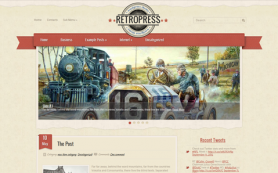Often, a customer’s first impression of a company comes from its website. This is especially true when it comes to small, developing companies that don’t have the advertising budgets of big corporations.
If you want your prospective customers to form a great first impression of your company, you want to use eye-catching branding on your WordPress website. However, this is easier said than done. There are a lot of nuances involved in website design and development.
Thankfully, WordPress offers plenty of great tools for branding your website. We’ll walk you through the entire process of effectively branding your WordPress theme in this post.
Why Is Branding Your WordPress Website Important?
Having a strong brand will help your prospects remember your company; it’s as simple as that. If you keep your branding clear and consistent, new customers will know what to expect, while your previous customers will have an easier time recognizing your products and content elsewhere.
Your website is a crucial part of the visual identity of your brand. It must contain all the elements used on physical materials, such as business cards or other forms of media.
Keeping your brand strong across all platforms is crucial, especially considering the fact that 71% of customers expect to have the same experience with a brand across all channels.
How to Brand a WordPress Theme
As we mentioned above, WordPress, fortunately, does an excellent job of making it easy to brand your website. Once you’ve set up your WordPress website, you can start adding branding elements to it, following the steps below:
Choose a Highly Customizable Theme with Many Branding Options
First, let’s talk about picking an appropriate theme to match your brand.
You need to pick a theme that offers plenty of options, allowing you to easily incorporate your desired branding elements.
This seems like a pretty straightforward step until you realize how many choices are available. However, having too many options is always better than not having enough, so take your time, and we’re sure you’ll find the right fit.
Once you’ve selected your theme, go to Appearance, then Themes, and choose Add New to install it to your WordPress site. You can search for free themes on the page that opens up or click the Upload Theme button to use a theme you’d purchased and downloaded earlier.
Follow the on-screen instructions to activate your theme, and you’re all set!
Design and Include Your Custom Logo
Your logo is probably the most important element in your branding, and it is vital to have it prominently displayed on your website. Your logo should be the first thing your visitors see, and it should be striking enough that they remember it even after they leave.
Some tools allow you to design your own logo if you’re feeling artistic. You also may be able to find a few royalty-free examples online. However, hiring a graphic designer to do it for you is probably a smart investment. You can also team up with a branding agency (with a strong background in design) if you want your brand design to make a stronger impact in the long-term.
Whatever route you choose to take, you’ll want to place your logo on your website once you have it. To do this, navigate to the WordPress Customizer by once again clicking on Appearance, then Customize in your dashboard. From there, select Header, then Logo.
This is where you’ll be able to upload your logo to show up in the header of your website. The process is similar if you want to add the logo to other locations on the site, such as the sidebar or the footer.
Build Your Brand’s Credibility via a Few Key Pages
Although your logo and your overall visual identity are crucial, they are not all that your branding should amount to. Your story is just as important.
As you’re probably aware, brands often rally around causes or focus on solving specific problems. Philanthropy aside, smart brand managers know that customers will feel closer to a brand if they can relate to it on a personal level.
This is why we often hear stories of billionaires who started their companies in their parents’ garage or while crashing on their friend’s couch. Everyone loves an underdog.
Whether you have an inspiring story to tell, or you’re simply interested in sharing more about your company’s goals, you’ll want to add an About Us page to your website. Other pages you should probably add at the very beginning include:
- Contact Us
- Blog
- Portfolio (if you perform a service)
- List of products
To create a new page on your WordPress website, click Pages, then Add New.
Make it Easy for Visitors to Get in Touch with You
There’s a reason you’ll want to include a Contact Us page in the very first draft of your website. Visitors must always have an easy way to reach you. As obvious as this may sound, a surprising number of business websites don’t do this very well.
Although most websites have contact pages, they fail to include different ways for customers to get in touch, such as CTA (Call to Action) buttons prominently displayed on important pages.
On top of these, feel free to include a phone number, email address, or even a live chat option. These elements, and others, can be added through various dedicated WordPress plugins.
Use Plenty of Content to Drive Home Your Message
In this day and age, content is an essential part of any website. If you want your site to be successful, especially in terms of SEO, you need content.
That is why most websites include a blog, which is a perfect way to present fresh content and create traffic for your website. Creating a blog page on your WordPress site should be a breeze; in fact, most themes come with one already included.
To customize your blog page, go to your WordPress dashboard, click on Appearance, then Customize, and select the Blog section to get started.
Try to keep your posts on brand — write about things that align with your brand’s overall message. Think about what your target demographic would like to read and try to create high-quality, engaging content.
If you want to make your content extra competitive, use tools like the Google Keyword Planner and create a strong keyword strategy.
 Members Area
Members Area




